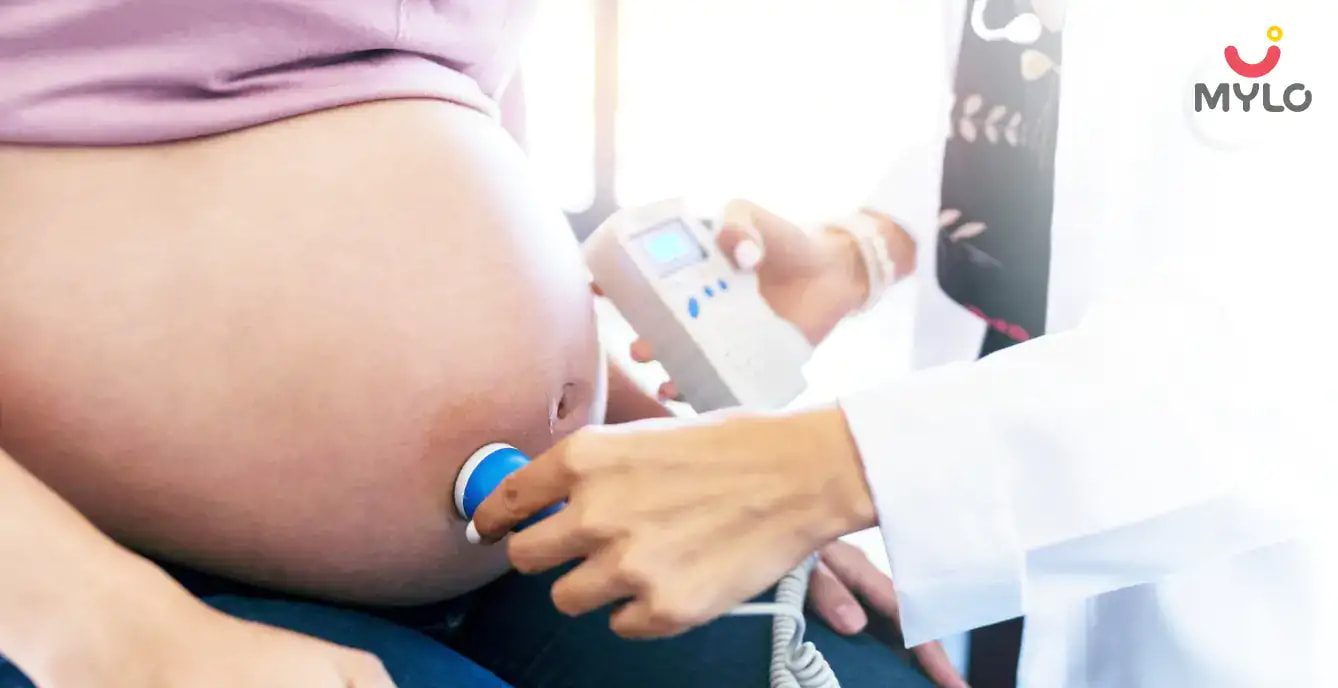Home

First Trimester

Is it Safe to Get an Ultrasound Done During the First Trimester of Your Pregnancy?
In this Article

First Trimester
Is it Safe to Get an Ultrasound Done During the First Trimester of Your Pregnancy?
Updated on 3 November 2023
As pregnancy ultrasound continues to gain value and popularity in obstetrics, it is sparking a debate amongst pregnant women regarding its safety. Many are concerned about whether these prenatal scans can harm the growing foetus or develop long-term side effects. While healthcare professionals continue to assure the safety of foetal life and the benefits of early screening, they agree ultrasound scans are ultimately a woman’s choice.
Pregnancy ultrasound scans have been conducted by healthcare professionals for decades. Substantial evidence supports that ultrasound scans do not harm pregnant women or their babies. According to a multicentre study conducted by World Health Organisation (WHO), exposure to diagnostic ultrasound during pregnancy appears safe. So, let’s try to end the dilemma for mothers-to-be who are awaiting their first ultrasound during pregnancy.
How does a pregnancy ultrasound work?
To ascertain the safety of ultrasounds and familiarise yourself before your first ultrasound during pregnancy, it is helpful to learn about how they work. An ultrasound scan uses high-frequency sound waves to create a picture of the baby in your womb. These waves develop echoes which are then turned into an image on a screen. The person performing the test (sonographer) interprets these images to learn about the baby’s position, movements and organs.
During the 15-30 minutes procedure, the sonographer rubs gel on your abdomen to ensure good contact between the machine and your skin. They use a transducer, a type of wand that emits sound waves, to capture the picture of your baby on the screen. Sonographers are trained healthcare professionals who follow all the proper guidelines to ensure your and your baby’s safety.
Can the ultrasound cause any harm or side effects?
Pregnancy ultrasound scans use sound waves at the lowest level and for the shortest time to minimise heat exposure. Additionally, these prenatal scans do not use x-rays or radiation. The first ultrasound during pregnancy is the most routine type of scanning and is non-invasive and painless. Medical studies have not found any link between ultrasound and congenital anomalies, childhood cancer, or developmental problems later in life.
During the pregnancy ultrasound scan, the transducer only generates a minimal amount of heat absorbed by the abdomen. Besides, prenatal scans produce less than 1 degree Celsius of heat spread over a large area, ensuring no harm is caused to the growing baby. Furthermore, the amniotic fluid around your baby and any movements they make helps to spread this heat further.
Is ultrasound necessary during the first trimester of pregnancy?
During the first trimester of pregnancy, the mother-to-be may not be showing much externally but she experiences a sea change internally. A healthy first trimester of pregnancy is crucial to the normal development of the foetus. Consequently, many pregnant women skip the first ultrasound during pregnancy to avoid harmful exposure to their babies. On the contrary, the first ultrasound during pregnancy can be beneficial in addressing any risks or complications.
An ultrasound scan during the first trimester of pregnancy can be key to establishing the due date, determining the number of babies you are carrying and examining the uterus. Additionally, doctors can diagnose an ectopic pregnancy, detect foetal abnormalities and assess the risk of miscarriage. The first ultrasound during pregnancy enables doctors to address some of these problems in utero and take timely interventions. So, go ahead and cross this off your first trimester pregnancy checklist.
What are the risks and benefits of pregnancy ultrasound?
Pregnancy ultrasound has no known risk, especially during the first trimester of pregnancy. Some pregnant women may experience mild discomfort because of the pressure from the transducer on the abdomen but other than that, there is nothing to worry about. Besides, having an ultrasound scan in safe medical settings by trained healthcare professionals ensures the elimination of all risks.
Pregnancy ultrasound is vital in providing valuable information to doctors as well as parents. For instance, an ultrasound during the first trimester can indicate if you are carrying twins and help you make necessary preparations. A pregnancy ultrasound can also have a bearing on the type of facility the woman should give birth at so the doctors are prepared to provide the proper postnatal care. Additionally, the first ultrasound during pregnancy offers parents-to-be a unique opportunity to see their baby before birth.
Are 3D and 4D ultrasound scans safe for the baby?
In recent years, high-end clinics have begun offering 3D and 4D scans. Deviation from the conventional 2D scans has raised a cause for concern among many pregnant women. 3D and 4D scans leverage higher power intensity to form clearer images and motion videos of the baby. Since these scans have a higher power output than 2D scans, a baby’s exposure to heat can increase. Therefore, doctors advise against 3D and 4D ultrasounds during the first trimester of pregnancy.
How many ultrasound scan pregnancy necessitate?
A healthy pregnancy with no complications requires only two ultrasound scans. The first ultrasound during pregnancy is called a dating scan and is performed during the first trimester of pregnancy. The second ultrasound is called an anomaly or mid-pregnancy scan, which takes place between 18-20 weeks of pregnancy. The anomaly scan checks for varied physical conditions in your baby. Sometimes, doctors may advise more than two pregnancy ultrasound scans, depending on your and your baby’s health.
Final Thoughts
Pregnancy ultrasound has been in use for the last four decades and boasts an untarnished record. No scientific data indicates that these scans harm the mother-to-be or the growing foetus. Nonetheless, it is recommended that pregnant women have ultrasounds only when medically necessary and under the guidance of trained healthcare professionals.



Written by
Anupama Chadha
Anupama Chadha, born and raised in Delhi is a content writer who has written extensively for industries such as HR, Healthcare, Finance, Retail and Tech.
Read MoreGet baby's diet chart, and growth tips

Related Articles
Related Questions
Influenza and boostrix injection kisiko laga hai kya 8 month pregnancy me and q lagta hai ye plz reply me

Hai.... My last period was in feb 24. I tested in 40 th day morning 3:30 .. That is faint line .. I conculed mylo thz app also.... And I asked tha dr wait for 3 to 5 days ... Im also waiting ... Then I test today 4:15 test is sooooo faint ... And I feel in ma body no pregnancy symptoms. What can I do .

Baby kicks KB Marta hai Plz tell mi

PCOD kya hota hai

How to detect pcos

RECENTLY PUBLISHED ARTICLES
our most recent articles

Diet & Nutrition
গর্ভাবস্থায় আলুবোখরা: উপকারিতা ও ঝুঁকি | Prunes During Pregnancy: Benefits & Risks in Bengali

Diet & Nutrition
গর্ভাবস্থায় হিং | ঝুঁকি, সুবিধা এবং অন্যান্য চিকিৎসা | Hing During Pregnancy | Risks, Benefits & Other Treatments in Bengali

Women Specific Issues
স্তনের উপর সাদা দাগ: লক্ষণ, কারণ এবং চিকিৎসা | White Spots on Nipple: Causes, Symptoms, and Treatments in Bengali

Diet & Nutrition
গর্ভাবস্থায় পোহা: উপকারিতা, ধরণ এবং রেসিপি | Poha During Pregnancy: Benefits, Types & Recipes in Bengali

Diet & Nutrition
গর্ভাবস্থায় মাছ: উপকারিতা এবং ঝুঁকি | Fish In Pregnancy: Benefits and Risks in Bengali

Diet & Nutrition
গর্ভাবস্থায় রেড ওয়াইন: পার্শ্ব প্রতিক্রিয়া এবং নির্দেশিকা | Red Wine During Pregnancy: Side Effects & Guidelines in Bengali
- ইনার থাই চ্যাফিং: কারণ, উপসর্গ এবং চিকিৎসা | Inner Thigh Chafing: Causes, Symptoms & Treatment in Bengali
- গর্ভাবস্থায় ব্রাউন রাইস: উপকারিতা ও সতর্কতা | Brown Rice During Pregnancy: Benefits & Precautions in Bengali
- Velamentous Cord Insertion - Precautions, Results & Safety
- Unlock the Secret to Flawless Skin: 7 Must-Have Qualities in a Face Serum
- Unlock the Secret to Radiant Skin: How Vitamin C Serum Can Transform Your Complexion
- Gender No Bar: 10 Reasons Why Everyone Needs a Body Lotion
- Unlock the Secret to Radiant Skin How to Choose the Perfect Body Lotion for Your Skin Type
- Top 10 Reasons to Apply a Body Lotion After Every Bath
- Communication in Toddlers: Milestones & Activities
- How to Improve Vocabulary for Toddlers?
- A Comprehensive Guide to Understanding Placenta Accreta
- Vulvovaginitis in Toddlers Causes, Symptoms and Treatment
- A Comprehensive Guide to Understanding Cerebral Palsy in Children
- Bitter Taste in Mouth During Pregnancy: Understanding the Causes and Remedies


AWARDS AND RECOGNITION

Mylo wins Forbes D2C Disruptor award

Mylo wins The Economic Times Promising Brands 2022
AS SEEN IN
















- Mylo Care: Effective and science-backed personal care and wellness solutions for a joyful you.
- Mylo Baby: Science-backed, gentle and effective personal care & hygiene range for your little one.
- Mylo Community: Trusted and empathetic community of 10mn+ parents and experts.
Product Categories
baby carrier | baby soap | baby wipes | stretch marks cream | baby cream | baby shampoo | baby massage oil | baby hair oil | stretch marks oil | baby body wash | baby powder | baby lotion | diaper rash cream | newborn diapers | teether | baby kajal | baby diapers | cloth diapers |








